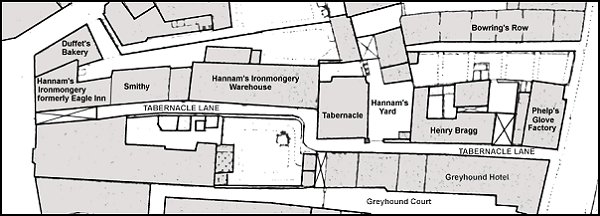bowring's row
bowring's row
also known as Bowring's Court
Bowring’s Row, also known as Bowring’s Court, was a 'court' of six cottages owned by Yeovil Corporation off the north side of South Street, opposite Pen Hill. The dwellings had gardens on the western side of their access path. The name derived from Robert Bowring, a baker, who purchased the cottages from the Corporation and owned them from 1813 to 1823. He was followed by his son, John Woodman Bowring, also a baker, who owned them until at least 1847, when he put the properties up for sale with a reserve price of £130 although there was no bid.
Although Bowring's Row was extant in 1813, and shown as such on the map of Corporation Properties of that year (see below) it had been built on the site of an earlier property divided into two tenements called Mill House
In 1871 'A True and Perfect Terrier' recorded "All that Burgage or Dwelling House called the Mill House and Garden aforesaid, in a certain street there called the South Street, formerly divided into two Tenements, but some years since taken down and six cottages built on the site thereof, and numbered 36 in the Corporation Survey, 1813, and which said premises fell into hand upon the death of Joseph Price, 1863."
In the 1851 census it was called Bowring's Court and housed the five families of glover layer out Thomas Davis, former dressmaker Mary Mansell, gardener Charles Davis, glove cutter John Vincent and carpenter journeyman John Andrews.
Bowring's Court was not identified as such in the census returns of 1861 to 1881 and the occupants were simply listed within South Street generally.
The 1886 Ordnance Survey names the court as Bowring's Row and the following census of 1891 also refers to it as Bowring's Row. Six families were living there in 1891, mostly associated with the glove trade. At No 1 lived fishmonger William Brake with his wife Dorcas and daughter Annie, both glove machinists. At No 2 lived 29-year old single mother Jane Brooks and her two baby daughters Mabel and Ethel. Jane was also a glove machinist. Widow Elizabeth Pardy , her daughter Kate and lodger Jane Preston, all glove machinists, lived at No 3 with Jane's son William, a steam engine driver. At No 4 lived shoemaker Joseph Barge with his wife and three children. Coach-smith William Hooper lived at No 5 with his glove machinist wife Hannah, their baby daughter and William's brother Henry, a wheelwright. Finally at No 6 lived widowed glove machinist Emily Williams and her daughter Fanny who was a general servant. Lodging with them was glove machinist Frank Josephs. A total of twenty two people with nine of the sixteen adults being glove machinists.
In the 1901 census it was called Bowering’s Row and of the five dwellings listed, one was unoccupied and nine people lived in the other four houses including two families each of just an unmarried mother and her daughter.
It was listed as
late as 1907 in
Collins'
Directory as
Bowring's Row,
South Street,
even though
Bowring's Row
had been
declared unfit
for habitation
in September
1906.
MAP

Part of John Martin's 1813 map of Yeovil showing properties owned by the Corporation in black. Bowring's Row is shown at centre bottom (above the 'R' in South Street) between Tabernacle Lane to the west and Grope Lane (today's Wine Street) to the east.

This map is based on the 1886 Ordnance Survey, but rotated 90° with the Borough at extreme left and South Street at extreme right. Bowring's Row is seen at top right running parallel with the southern part of Tabernacle Lane.